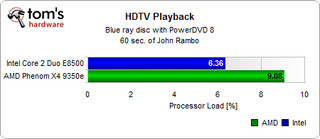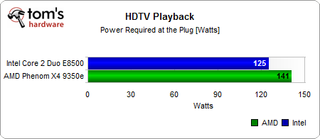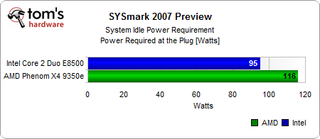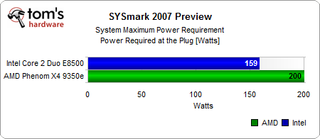Dual-Core Versus Quad-Core: Part 2
Blu-ray Playback & Power Consumption
Blu-ray Playback

Playing Blu-ray video on our test systems caused a 6.4% average processor load on the Intel Core 2 Duo machine and around 9% on the Phenom X4 9350e. Both were equipped with an ATI Radeon HD4850 card by GeCube, which provides acceleration for HD video with HDCP.

The Intel system not only has a lower CPU load when playing Blu-ray video, it also required less power to work on this task. The difference can partly be attributed to the platforms being different, although the discrepancy in overall power requirement is not significant. But the Core 2 Duo E8500 is much more efficient when it’s idle, and since DVD playback taxes the graphics chip but doesn’t require much processor activity, both CPUs are not too far away from idle—they at least switch back to their lowest clock speeds utilizing Cool’n’Quiet (AMD) or SpeedStep (Intel) respectively.
Power Consumption

System idle power consumption was rather impressive on the Intel system, given that it runs the P45 chipset (which requires slightly more power than the P35) and the same graphics cards: 116 W compared to 95 W means almost 20% less idle power for the Intel system in the case of our test systems. The difference, however, is acceptable, as we’re looking at a quad core processor, which is capable of beating the Intel dual core if only some additional applications were optimized for more than two cores.

Since we tracked power consumption during an entire SYSmark 2007 Preview run, we took the peak power requirement for the peak power comparison. The 200 W we measured for the AMD quad core and 159 W we got for the dual core system is close to what we expected.
Stay on the Cutting Edge
Join the experts who read Tom's Hardware for the inside track on enthusiast PC tech news — and have for over 25 years. We'll send breaking news and in-depth reviews of CPUs, GPUs, AI, maker hardware and more straight to your inbox.
Current page: Blu-ray Playback & Power Consumption
Prev Page Performance: SYSmark 2007 Preview Next Page Efficiency: Crysis TestMost Popular

